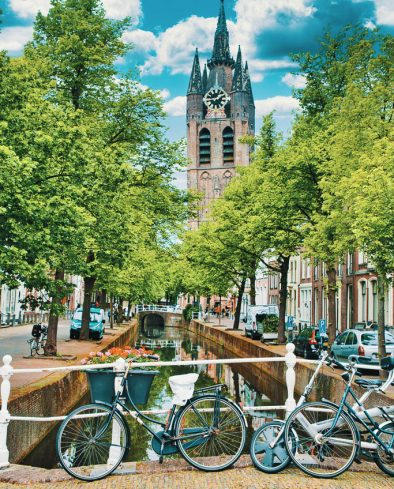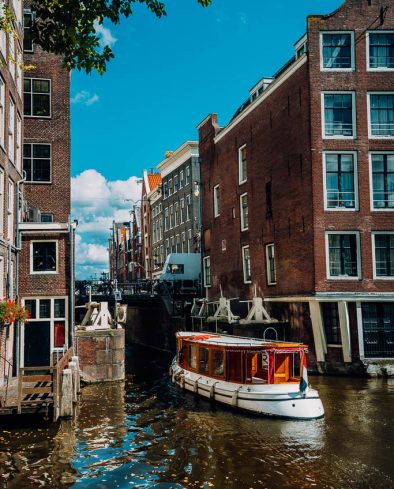Episode 31 - Delft
Delft was the first capital of the Netherlands and continues to be the country’s cutest old-world city.
Listen Now
Delft Is A City Of Canals
Today let’s go on a journey to the Netherlands, the lowlands, a journey to Delft — the country’s first capital. Do they still wear clogs in Holland? I always wondered, and I was delighted to find out that they do still wear clogs in Holland. They also have other strange traditions like pickled herring. You get it from the fishmonger, hold it up above your mouth, tip your head back and then slurp it with some onions. Surprisingly delicious.
Amsterdam of course is the famous destination of the Netherlands. It’s amazing how many people have heard of Amsterdam. They will even know it’s in the Netherlands. Delft, just like Amsterdam, is a city of canals. A city that is cute and old-world, a city where you can walk and cruise and bicycle instead of drive. And the thing I really like about the Netherlands is, it so small and so well-connected. Everything is close to Delft. In one sense, because hey, you can cross the Netherlands in less than two hours.
You can go from Amsterdam to Delft on the train in 50 minutes. Everything is so close that it’s really easy to go for two or three days, four days and get a huge variety of experiences and destinations. And the one I really liked the most is this one called Delft. It’s famous for its pottery, Delft blue, very well-known across the world, especially — it was the great pottery of the world back in the 15th and 16th century. And as you arrive in Delft, you see these incredible church towers that were at one point the tallest buildings in the Netherlands.
The New Church And The Old Church
And you travel over a canal into the old town where bicycles tinkle past, where footsteps are what you hear, not motor vehicles. And that first church you reach is called the New Church. It’s called the New Church — and it was built before Columbus first sighted America. Entering that New Church, you will find the place where all the Dutch monarchs are buried. That’s a Gothic-style building. And across the way is the city hall, from the 17th century.
It’s a Renaissance building. Somewhere in between them is the Alleyway, the building where young Vermeer, one of the world’s most famous painters, was born and lived. And then a little further on, as you wander down the canals — or perhaps take a boat down the canals, perhaps cycle over the cobbles — you’ll find the Old Church. And for me, the Old Church is where it got really interesting, because the entire floor of the Old Church is covered in tombstones, big slabs of stone that have essentially created the floor of the church.
And on that floor, all the names and the details of the people who are buried there, just like any tombstone really. And i,t’s in this church where all the tombstones have got skulls and crossbones. So if you had money and you’re a pirate, back in the day, you could afford to be buried in such a grand church. And of course you got buried with the schools and crossbones. And there are some really, really funny guides who can tell you some of the stories about the people buried beneath the floor of the Old Church in that crypt.
People with fascinating, gory tales that sound pretty Hollywood, they sound pretty Johnny Depp in Pirates of the Caribbean. I loved being there, just wondering, seeing the skull and crossbones and imagining who is this person who died in the 16th century, what story did he have? How did he come to be here, in what was at the time one of the grandest buildings for a thousand miles around?
A Place Of History And Stories
Coming out of the Old Church, my guide showed me the place where William of Orange escaped. So Holland — the Netherlands — was a Spanish colony, believe it or not. And they were fighting what turned out to be an 80-year war for independence. And William of Orange was a German, initially loyal to Spain, who stimulated this independence movement. And he was being hunted down by Spain. He was hiding in a nunnery, which you can visit. He was shot in a nunnery and you can still see the place in the wall where the bullets went. And from there, there is an escape patch that goes from the nunnery — an escape hatch that goes down to the canal where he would have been able to escape by boat out of Delft.
But unfortunately he wasn’t. Fortunately for the Dutch, they did find their independence and Delft was to become the first capital of the Netherlands. So it’s in Delft that you really find the history of Holland. And of course there are other things, the other things that if you’ve heard of Delft, you want to see. The Delft blue pottery workshop. You can even do a private pottery painting workshop. And then there’s the other side of Holland. The modern Holland, the cafe terraces, the bars, the stores, the bicycles, the delights that you can find when there are no vehicles in a huge area that’s pedestrianized And there is a lot more to this tale, but I’m not the best person to tell it — the best person to tell it is a travel designer in Delft.
It’s a guide in Delft who knows the history of Holland. So check it out at Kated.com — History of Holland Delft Tour.



